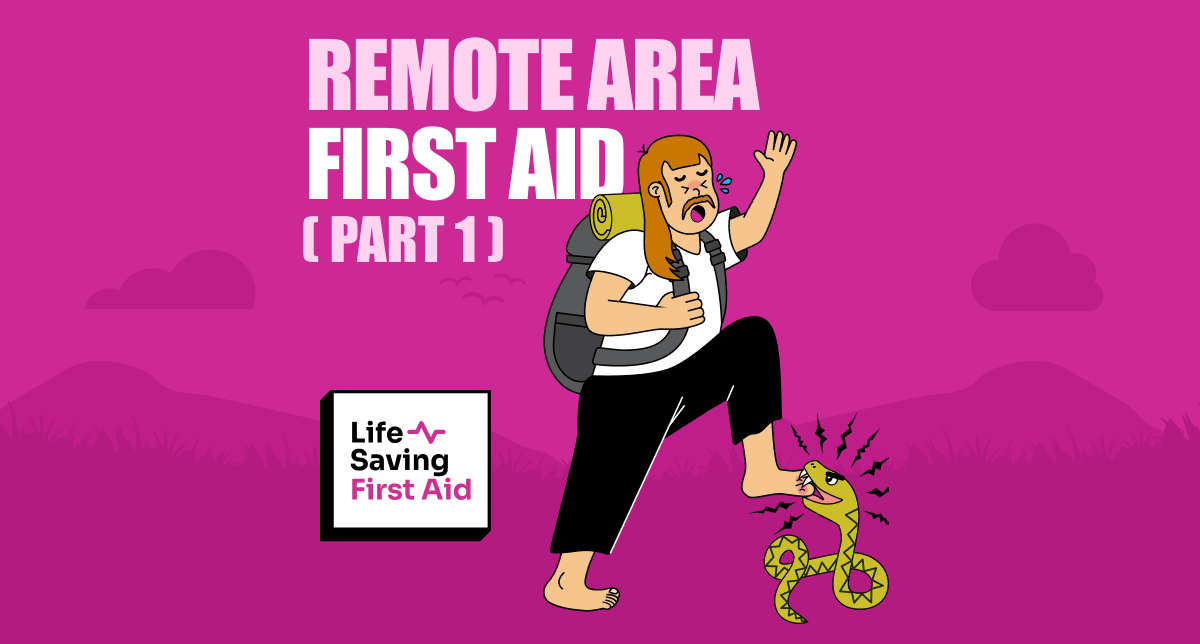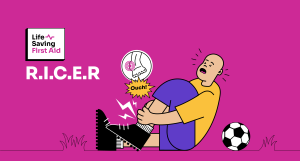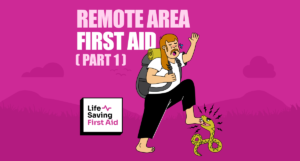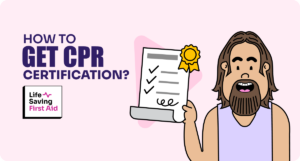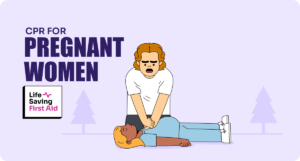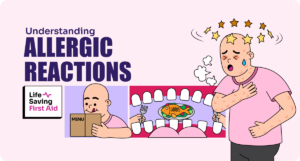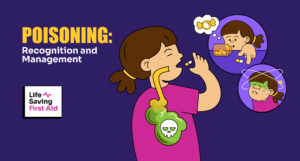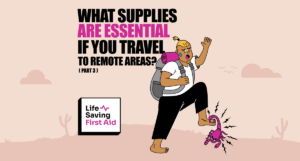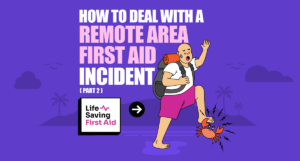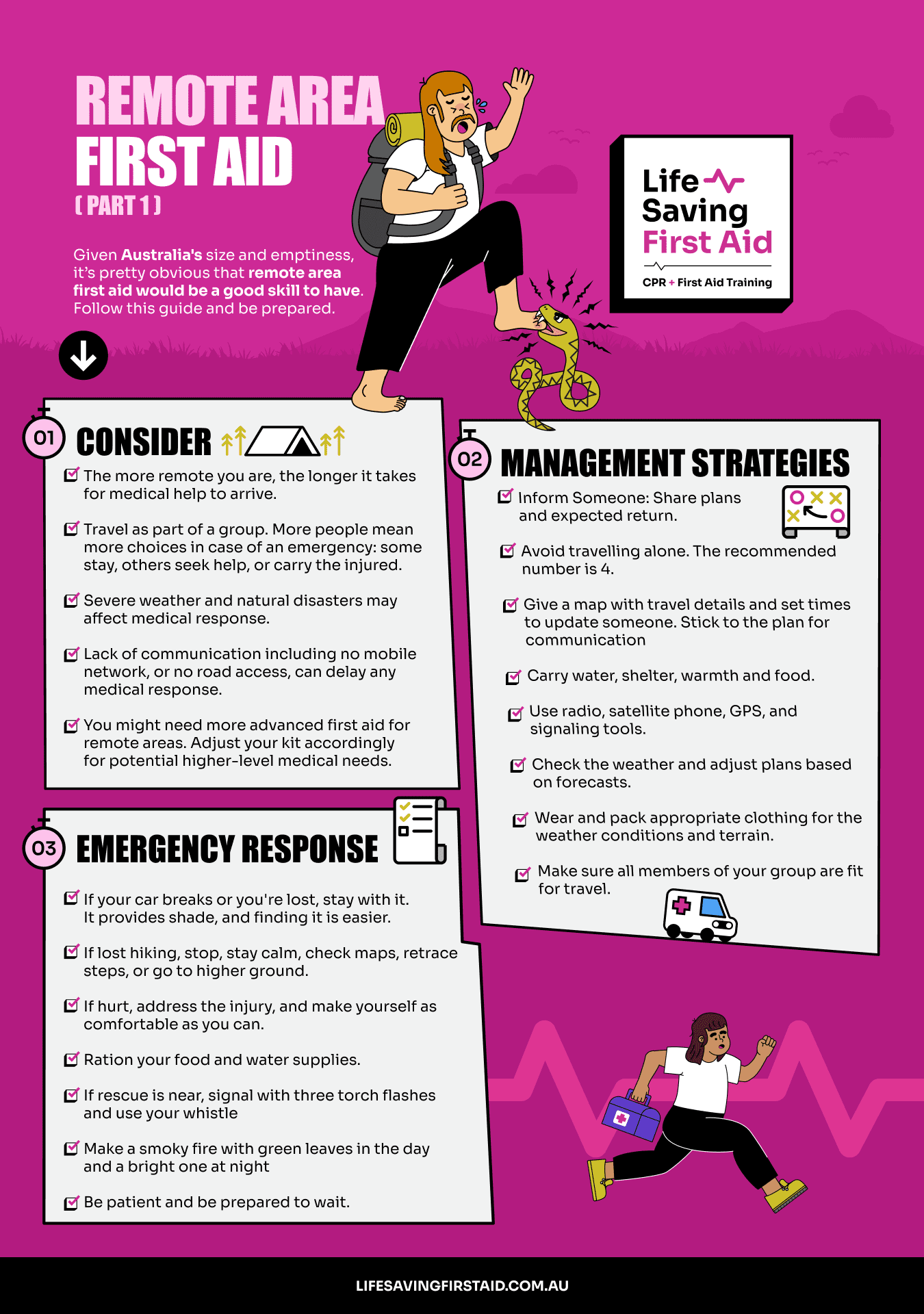
Introduction
Given Australia’s size and emptiness, it’s pretty obvious that remote area first aid would be a good skill to have. If you don’t know how barren Australia is just have a look at Australia on Google Maps. Use the satellite view and a nighttime view as well. There’s a couple here – Night Time Australia.
Australia is empty.
A remote area is generally defined as an area where access to medical assistance is delayed by time and distance, which is most of inland Australia.
However, remote for First Aid purposes could be anything over an hour, or 50 km, from a city or a country town.
If you are in a remote area and have the ability to manage injuries with skill and confidence you may be able to prevent complications. Complications which would hinder a speedy recovery.
Because you can’t call an ambulance and expect one to arrive within a reasonable time, remote area first aid has its own unique set of considerations.
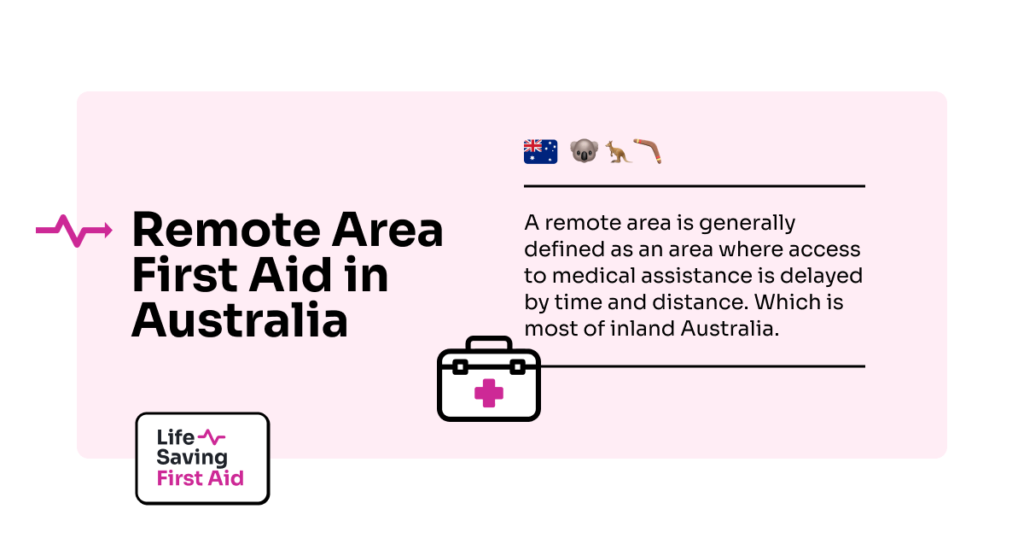
Remote area First Aid considerations
- Distance – The further you are from medical/ambulance assistance generally means it will take longer for that assistance to reach you.
- Time – As for distance, the further away the more time it will take. However, in some cases, you may only be a couple of miles away from aid BUT it may take days to reach you. Mountainous areas for example.
- Number of people in the affected party – This will determine what can be done if someone becomes injured. The more people in the group, the more options you may have. One or two people could stay with the casualty, others could go for help. There may even be enough people to carry the injured person out.
- Weather Conditions – Storms may prevent aircraft, as well as land transport, from reaching the casualty. High temperatures may inhibit a quick on-foot rescue. Deep snow the same.
- Fire and Flood – (What? In Australia? – surely not!) There’s no denying that these are fairly commonplace within Australia. These natural disasters will have an impact on medical response time if they are happening in your area.
- Lack of communication – No mobile network. No road access. Lack of communication will, of course, delay any medical response. Lack of communication may also deprive you of contact with a doctor and the provision of medical advice.
- Medical supplies – When travelling in remote areas the level of first aid you may be required to perform may be higher than the level of first aid closer to home. This will have an impact on the contents of your first aid kit.
- The severity of the injury – This will determine your actions and response.
After reading the list above you can see how isolated you might feel if you are out in the great outdoors with a couple of friends and something injurious happens.
Let’s make it worse… You’re by yourself.
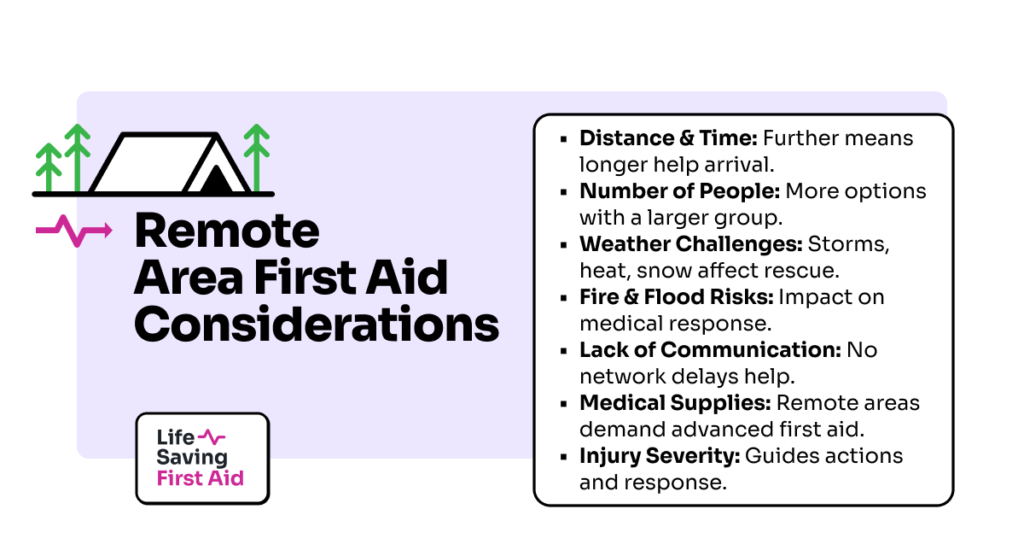
Management Strategies for remote area First Aid
While there are some extra things you need to consider for remote area first aid, it is important to remember that the basic principles of first aid remain the same.
The initial action plan of DRSABCD is just as valid in a remote area as it is in the suburbs. What does make a difference is a sound knowledge of survival techniques and correct preparation before remote area travel is undertaken.
The Basics
- First and foremost, tell someone where you are going and when you expect to be back. You might even organise before you leave what to do if you do not return at, or close to, the expected time.
- Avoid travelling alone. The recommended number is 4. That way one can stay with the injured person and two can go for help.
- Leave a map with your travel details on it and organise a schedule of times when you will contact a nominated person. Keep to the schedule.
- Remember there are four vital requirements to support life. Water, shelter, warmth, and food. Make sure you set out with an adequate supply of these vital requirements to sustain you should you become stranded. Even if you are planning to go to a remote area for only a short period.
- Take appropriate communications and location equipment for the area you are going to. Know how to use them. These may include a long-range radio or mobile satellite phone, global positioning system, emergency position indicating radio beacon and maps. Use a torch, whistle or mirror to signal for help.
- Check weather forecasts before you depart and while you are away. Be ready to change your plans or delay the trip if necessary.
- Ensure all members of your group are fit for travel. Carry extra prescription medications for the journey.
- Wear and pack appropriate clothing for the weather conditions and terrain.
So, planning and preparation beforehand is the key. However, even the best preparation and planning cannot prevent an emergency.
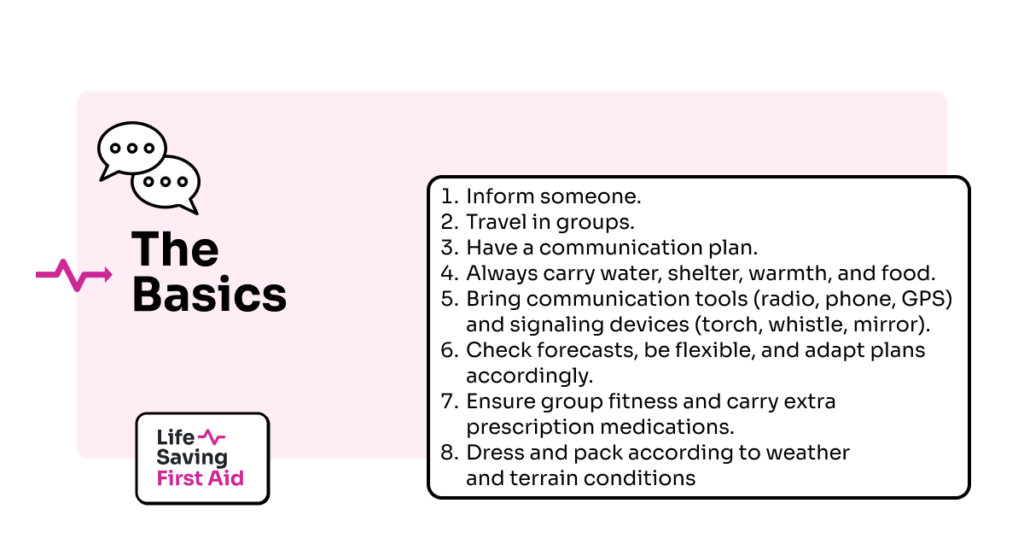
Remote Area First Aid emergency
If well planned, your trip should go smoothly and safely, but if you get into difficulty, here are a couple of key things to remember:
- if your car breaks down or you become lost on the way, never leave your vehicle. You can use it for shade and shelter. Also, it is easier to locate a missing vehicle than a missing person in the vast Australian Outback.
- if you become lost while hiking, stop, try to relax, and study your maps. See if you can determine where you came from and slowly make your way back. If you can’t find your way back, move to higher ground for a better view.
- If you become injured, deal with the injury and try to make yourself as comfortable as possible.
- Ration your food and water supplies.
- If you hear signs of rescue, signal with three torch flashes and with your whistle.
- Light a small smoky fire with green leaves during the day and a small bright fire with dry materials at night.
- Be patient and prepared to wait.
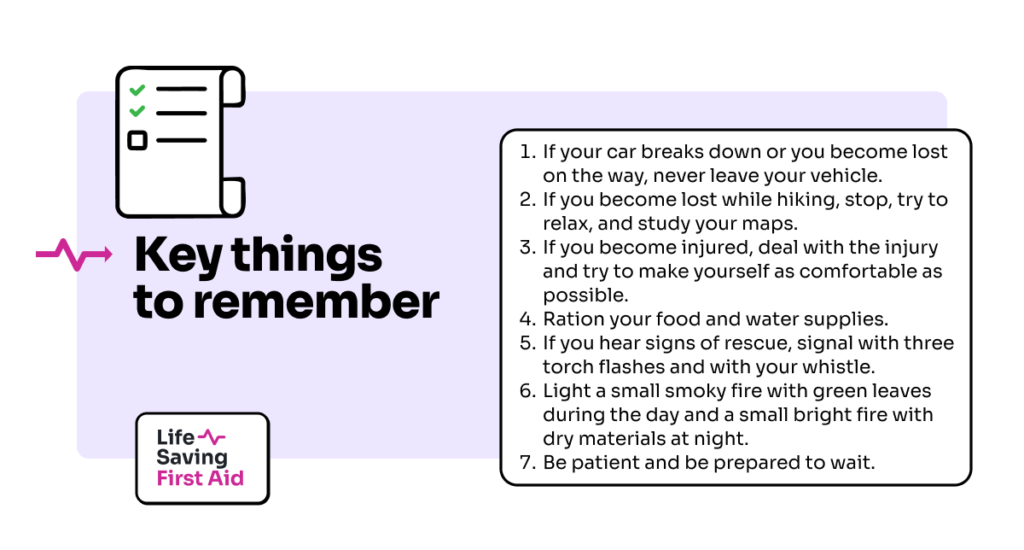
Other outback emergency considerations especially if you are in a group.
- Continue or stop. Somebody will have to decide whether the casualty is able to continue the journey, or it should be abandoned to care for the injured person. Or maybe take them out to medical aid. Whoever makes that decision should consider the welfare of the whole group.
- Medical assistance. If you are able to call for assistance you will now have to decide whether you go to the assistance or wait for the assistance to come to you. The severity of the injury, time factor – travel out vs travel in. Can the casualty even be moved? Will determine your decision.
- Time Frame. Because of the distance and extended time frame for assistance, the casualty may become more stressed. The decision maker/first aider will need to remain calm and reassure the casualty. Regularly monitoring the casualty’s condition will help reduce anxiety levels. Make sure they are as comfortable as possible.
- Observations. Keep notes on the casualty’s condition. Record things like changes in signs and symptoms, vital signs, and first aid provided. Monitor and record fluid intake and output. Be aware that the casualty may go into shock.
- Shelter and survival. Try your best to shelter the casualty from the elements. Keep them as comfortable as possible. Keep cool if hot and warm if cold.
Ok. Now all of the above may have felt like death by dot point. But when you stop and think about it, moving around this great empty country of ours does require planning and preparation.
There are about 40 deaths per year in the Australian outback. Most are due to motor vehicle accidents. However, people do perish directly as a result of poor preparation.
Check this out: How a desert claimed two ill-prepared travellers.
Conclusion
If you want to hike around in remote parts of Australia then I suggest you do your research, complete a Provide First Aid in a remote or isolated site course, plan your trip – using the above articles as a guide and try not to travel alone.
I have deliberately not given details of how to deal with First Aid emergencies, contents of first aid kits, communications equipment etc.
I will cover those in Part 2 of Remote Area First Aid.
Well, that’s that. Until next time…Stay safe
